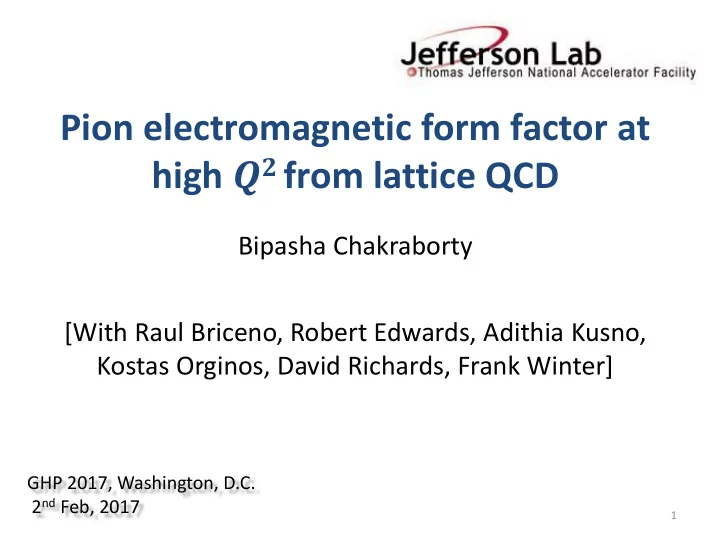

Pion electromagnetic form factor at high 𝑹 𝟑 from lattice QCD Bipasha Chakraborty [With Raul Briceno, Robert Edwards, Adithia Kusno, Kostas Orginos, David Richards, Frank Winter] GHP 2017, Washington, D.C. 2 nd Feb, 2017 1
Definition + π Simplest hadron p 1 𝛿 Space like “ 𝑟 ”: q 𝑟 2 = (𝑞 2 – 𝑞 1 ) 2 ≤ 0 p 2 + 𝑅 2 = −𝑟 2 π (in units of ‘ 𝑓 ’) 2
Interplay between hard and soft scales Hard tail (Q 2 → ∞ ) from pQCD: 16ᴨα 𝑡 𝑅 2 𝑔 π 2 𝐺 𝜌 (𝑅 2 ) → 𝑅 2 G. P. Lepage, S.J.Brodsky, Phys. Lett. 87B(1979)359 Soft part ( 𝑅 2 < 1 GeV 2 ): vector meson dominance with 𝐺 𝜌 (0) = 1, data fits well G. Huber and D. Gaskell Need better understanding of the transition to the asymptotic region 3
JLAB 12 GeV upgrade G. Huber and E. Gaskell 𝐺 𝜌 measurements at 𝑅 2 ~ 6 GeV 2 : E12-06-101 at JLAB Hall C Can we get some insight from first principles lattice QCD calculations to the question - where does the transition to pQCD happen? 4
Lattice recipe for meson correlators • Expectation values of observables : • 4-D space-time lattice • Gauge configurations : gluons + sea quarks • Discretise : • Inversion of Dirac matrix : propagator • 2-point, 3-point correlation functions : extract meson properties • Corrections for lattice artifacts 5
Two-point correlator construction • Basis of operators 𝑢 1 𝑢 2 • Optimized operator for state |𝑜 > in a variational sense by solving generalized eigenvalue problem- • Diagonalize the correlation matrix – eigenvalues λ 𝑜 𝑢 = exp [−𝐹𝑜 𝑢 − 𝑢 0 ] 6
Two-point correlator construction Correlator Construction: smearing of quark fields - ‘distillation’ with Low lying hadron states Meson creation operator : Parambulators by inverting the Dirac matrix + Operator construction with momentum projection 7
Meson Spectrum Tools well established for spectroscopy Hadron Spectrum Collaboration Jozef J. Dudek et. al . Phys.Rev. D88 (2013) 8
Form factor calculation Need three-point correlator + (𝑞 2 )|𝐾 𝜈 + (𝑞 1 ) > = 𝑓(𝑞 1 + 𝑞 2 ) 𝜈 𝐺 𝜌 (𝑟 2 ) 𝑎 𝑊 < 𝜌 𝜌 (0)|𝜌 Z V calculated using F π (q 2 = 0) = 1 9
Pion electromagnetic form factor: up to 𝑹 𝟑 = 𝟐 GeV 2 Amendolia et. al. JLAB expt. JLAB (Had. Spec.) Phys.Rev. D91 (2015) JLAB lattice ongoing 𝑛 π = 750 MeV In agreement with recent lattice result from HPQCD (up to 0.25 GeV 2 ) Phys.Rev. D93 (2016) 𝑛 π = 450 MeV Anisotropy 𝑏 𝑡 = 3.44 𝑏 𝑡 = 0.12 fm, 𝑏 𝑢 10
Towards higher 𝑹 𝟑 More difficult on lattice for higher momenta Signal-to-noise ratio: π π Noise π π 2-point correlators : exp [−(𝐹 𝜌 (𝑞) − 2𝑛 𝜌 )𝑢] Minimize energies 3-point correlators : for a given 𝑅 2 to get better signal exp [−(𝐹 𝜌 (𝑞𝑗) + 𝐹 𝜌 (𝑞𝑔) − 2𝑛 𝜌 )𝑢/2] in the middle of the plateau 11
Towards higher 𝑹 𝟑 Dispersion relation: … …. Achieve maximum 𝑅 2 by using Breit frame : 𝑄 𝑔 = − 𝑄 𝑗 12
Outlook Immediate goals: Pion form factor at 𝑅 2 ≥ 6 GeV 2 Extend to more ensembles with lighter pion masses , multiple volumes, multiple lattice spacings Take care of lattice artifacts Long term goals: Hadron structure program – distribution amplitude, PFDs, Quasi PDFs Extend to nulceons & more – charges, moments, TMDs, GPDs …. 13
Recommend
More recommend